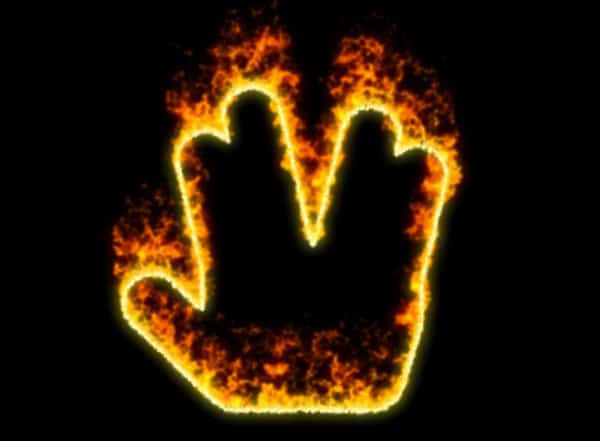By turns futuristic and anachronistic, spacefaring fire tech helps Starfleet personnel live long and prosper—usually
Let’s start with some unusual facts about fire in space (at least when oxygen is present):
- Smoke and fire don’t rise in low gravity—and can spread in any direction.
- Fires take on a spherical shape and “[create] different amounts of soot, smoke, or harmful gases.”
- On Earth, fire extinguishers are designed primarily to stop fires before they’ve grown too large. But in low gravity, extinguishers can move air toward fires, prolonging the burn.
- “Cool flames”—invisible, low-temperature fires—may persist even after visible flames have stopped.
Today’s scientists have adapted in some clever (if surprisingly simple) ways to detect and put out fires in space. The International Space Station features smoke detectors in air ducts, where they respond to smoke as it circulates through the air. When a fire strikes, astronauts shut off ventilation systems, turn off electrical equipment, and use fire extinguishers after flames are contained.
In the Star Trek franchise, however—set largely after the year 2063, when humans ostensibly develop faster-than-light travel—fires behave more like they do on Earth. With a handful of exceptions, artificial gravity is a given throughout the series, making starships and space stations more like seafaring vessels and buildings than today’s spacecraft.
So, how does the United Federation of Planets (UFP) respond to the challenge of fires in space? To learn more about fire protection technology in Star Trek and its real-world analogs, “let’s see what’s out there” and engage.
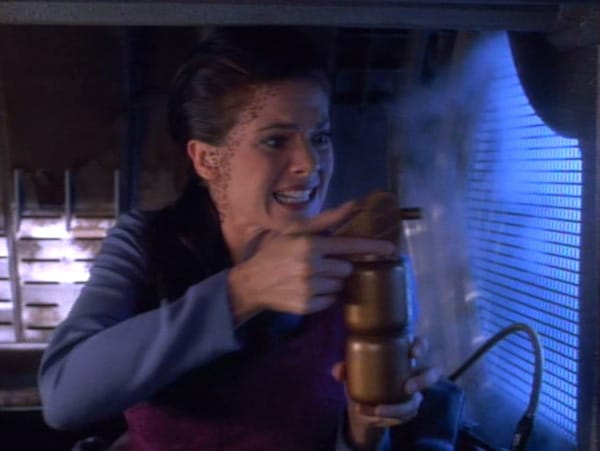
Star Trek: The Next Generation imagines technology that uses electricity to fight fires in space
Some ships in Star Trek have the fire protection features we’re used to. Fire extinguishers? Check. Signs guiding people to activate alarms and evacuate? You bet.
But Star Trek: The Next Generation (TNG) envisions something a little more futuristic. In “Up The Long Ladder” (Season 2, Episode 18), the USS Enterprise-D rescues more than 200 Amish-like refugees from a planet facing extinction.
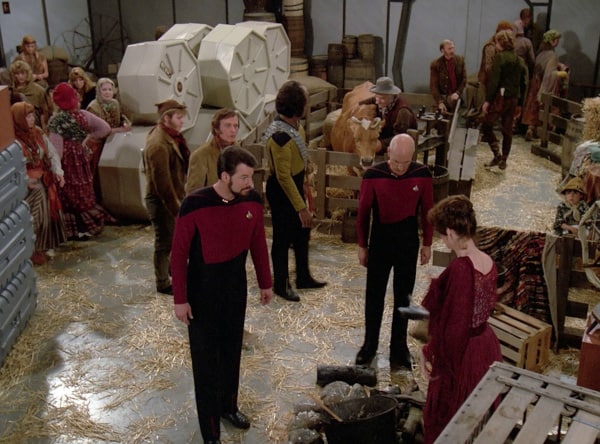
In the words of Den of Geek’s James Hunt, this episode is “not TNG’s finest hour.” However, the Bringoldi—a group of space-farmers with inexplicably Irish accents—do reveal something interesting about the ship’s fire protection systems while cooking in a cargo bay.
From “Up the Long Ladder” (Star Trek: TNG)
[BRINGOLDI] MAN: What the hell was that thing?
[LIEUTENANT] WORF: Automated fire system. A forcefield contains the flame until the remaining oxygen within the field has been consumed.
MAN: What if I had been under that thing?
WORF: You would have been standing in the fire.
MAN: Well, leaving that aside for the moment, I mean, what would have happened to me?
WORF: You would have suffocated and died.
MAN: Sweet mercy!
Star Trek: The Next Generation—Technical Manual tries to fill in some of the gaps in the science (or fantasy) behind Gene Roddenberry’s vision of space exploration. According to the Manual, a single device combines a variety of detectors—heat, smoke, ionization, and gases—with projectable forcefields. These forcefields both deprive the fire of oxygen and use the fire’s own carbon dioxide exhaust to suppress small fires.
Technology that starves fires of oxygen—or fights them with electricity—isn’t confined to space or Star Trek
Are there analogs for forcefields in today’s fire protection systems? Not exactly.
Every fire has four basic elements: heat, air (oxygen), fuel (things that burn), and a chain reaction—the feedback between heat and fuel that produces flammable gasses. While fires may belong to one of several types, any fire can be stopped by removing one of these elements.
The principle of Star Trek: TNG’s firefighting forcefields—to run the fire out of air—has real-life parallels. On the International Space Station (ISS), smoke detectors automatically shut off ventilation to areas affected by a fire. For especially large fires, the crew can seal off whole sections of the ship. In either case, the idea is the same: take away the fire’s oxygen.
For the same reason, the UL Firefighter Safety Research Institute (UL FSRI) promotes closing doors while sleeping, which can drastically lower temperatures (and the concentration of toxic gases) in rooms adjacent to a fire. “’With the doors and windows closed,’ adds Stephen Kerber, director of UL FSRI, ‘the fire won’t have oxygen to burn and it’s going to stay right there[.]’”
However, the use of electricity in firefighting—while still a technology of the future—has shown promise. In 2008, the Defense Advanced Research Projects Agency (DARPA) challenged scientists to develop fire suppression tactics based on electric fields or sonic waves. Just three years later, scientists at Harvard University responded by developing a device that successfully extinguished a small flame with an oscillating electric field, as shown below:
The team speculated that these devices repelled electrically charged particles within the fire. In essence, the field generator separated the flame from the fuel, stopping the fire instantly.
Failures of fire suppression systems, while rare on Earth, are all too common on fictional starships
Risk management is the core of fire safety. In buildings with fire sprinkler systems, you might find fire alarm pull stations, fire extinguishers, and alarm systems that shut off ventilation in the event of a fire. Each serves as a failsafe, making firefighting possible even when something (else) goes wrong.
Further reducing these risks are measures against human error. For example, closing just one valve can paralyze a building’s entire fire sprinkler system. Fire codes typically require those valves, called control valves, to be secured and/or send a warning signal when the system is impaired.
Buried in the more than 47,000 articles contained on Memory Alpha, an online encyclopedia for all things Star Trek, is an entry on fire suppression systems. In six of the seven instances of fire cited, fire suppression systems failed. Yet even in our optimistic spacefaring future, it’s a mix of human error and mechanical failure that can make a fire so deadly. Take Star Trek: TNG, where a few more words from the ship’s captain would’ve vented a child (Alexander) into space.
From “New Ground” (Star Trek: The Next Generation)
[LIEUTENANT] WORF: Sir, there is a fire in biolab four. The fire suppression apparatus is not functioning.
[CAPTAIN] PICARD: Seal off the compartment. Prepare to vent the air from—
[LT. COMMANDER] DATA: Sir, there are life forms present in that biolab.
[COMMANDER] RIKER: We’re transporting endangered animals from Corvan Two.
DATA: Readings also indicate the presence of a humanoid, Captain.
PICARD: Computer, identify humanoid life form in biolab four.
COMPUTER: Life form is identified as Alexander Rozhenko.
PICARD: Bridge to biolab four. Alexander, can you hear us?
WORF: Sensors show he is alive. He may be injured.
RIKER: Can we transport him out of there?
WORF: Transporters are still offline.
Whoa. And today’s fire protection engineers, contractors, and firefighters thought they had problems.
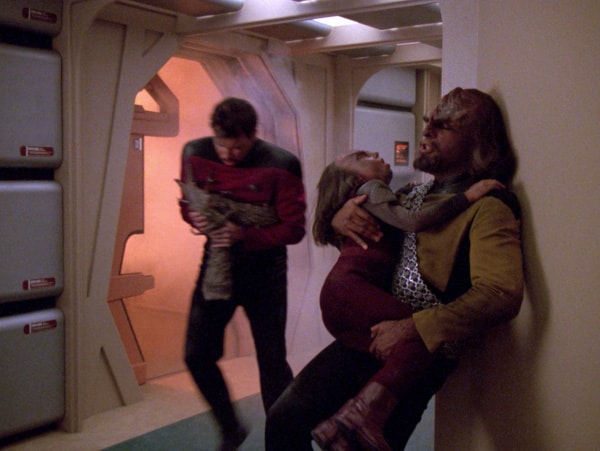
If Star Trek were real, technology would likely make quicker, more informed decisions regarding fires
While it’s true that we’ve omitted some details from the story above—a test of new faster-than-light technology has gone awry, damaging systems throughout the ship—what’s most surprising here is the lack of integration between the ship’s different sensors.
In today’s fire protection systems, it’s common to have a wide array of sensors coordinated by one or more fire alarm control panels. Everything from smoke and heat detectors to hand-activated switches can transmit a signal to a panel. In turn, the fire alarm system may take a variety of actions ranging from flashing a light at the panel to automatically closing fire-rated doors.
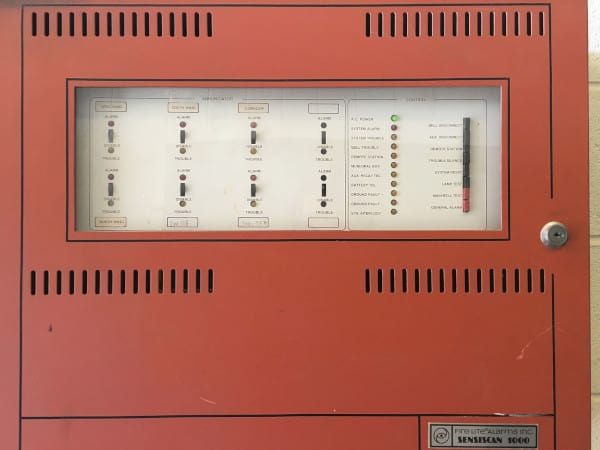
In fact, testing of integrated building systems was introduced as a mandate in the 2018 edition of NFPA 101: Life Safety Code:
40.7.4.1 Integrated fire protection and life safety systems shall be tested in accordance with 9.11.4.1.
These integrated fire protection and life safety systems are defined by NFPA 4: Standard for Integrated Fire Protection and Life Safety System Testing as those “required to operate together as a whole to achieve overall fire protection and life safety objectives.”
Similarly, a type of fire sprinkler system called a preaction system takes multiple inputs into account before providing water to sprinkler heads. To reduce the number of false alarms, a preaction system often waits for an additional signal to verify the presence of a fire. These systems are often used in art galleries, museums, and other areas with artifacts or equipment that might be damaged by sprinklers’ accidental water discharge.
The Enterprise has all of those sensors and more—including a way to detect whether or not a living human being is present. Yet rather than integrating all of these sensors (and including safeguards against human error), it’s up to the crew to note and rapidly communicate conditions that might make some fire protection measures ineffective or even dangerous.
Will Star Trek’s fire protection systems be left to the past—or made part of the future?
In Star Trek, fires in space often aren’t like real fires in space. But by modeling starships after the world we know, the franchise offers a mix of futuristic suggestions and cautionary tales about the balance between staying safe and, well, boldly going. Star Trek’s technology has already inspired the developers of portable music players and mobile phones. And while—for the moment—forcefields aren’t as common as fire sprinklers, it’s not hard to envision a future where they are, especially given some of the current research by DARPA.
If you’re interested in the evolution of fire safety tech, check us out at Facebook.com/QuickResponseFireSupply, on Twitter @QuickResponseFS, or stay current with us at blog.qrfs.com.
In a more modest vein, we’ve already cast our eyes to the future with articles on how fire safety and urban design are changing cities, the digital present and future of fire safety inspections, and the path forward for home sprinkler systems—and look forward to bringing you more as technology and practices evolve. Especially if they ever involve force fields.
This blog was originally posted at blog.qrfs.com. Call us at +1 (888) 361-6662 or email support@qrfs.com for questions or help finding fire protection equipment.


